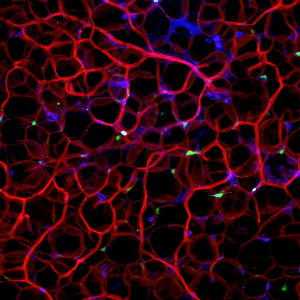Obesity: a dangerous immune response
16 Mar 2022
An unhealthy diet leads to fatal activation of immune cells. A team of researchers from LMU, in collaboration with the Harvard Medical School in Boston, has uncovered new molecular influences.
16 Mar 2022
An unhealthy diet leads to fatal activation of immune cells. A team of researchers from LMU, in collaboration with the Harvard Medical School in Boston, has uncovered new molecular influences.

© IMAGO / Westend61
Overweight and obesity are among the biggest health challenges of the 21st century, according to the World Health Organization (WHO). Almost 60 percent of Germans are considered overweight, while 25 percent are obese. Moreover, being overweight often triggers severe secondary diseases such as diabetes, arteriosclerosis, or heart attacks.
What troubles physicians, is the size of fat tissue in the abdomen – or visceral adipose tissue, to be technical. Strong expansion of this tissue is associated with an inflammatory immune response that encompasses the whole body and thus increases the risk of secondary diseases. Visceral adipose tissue plays an important role in these processes: Here immune cells can arrange themselves into lymphoid structures and instigate immune responses that derail the person’s metabolism.
After only three weeks of a high-fat, high-caloric diet, we see changes in the molecular processes that control the immune system and the metabolism in the organism.Susanne Stutte
A team of researchers at LMU has now investigated the molecular processes that influence this so-called immunometabolism. They found that diet plays a decisive role: “After only three weeks of a high-fat, high-caloric diet, we see changes in the molecular processes that control the immune system and the metabolism in the organism,” explains Dr. Susanne Stutte from the Biomedical Center Munich and lead author of the study. Excess food energy is stored in adipose tissue, such as visceral fat, which is located in the abdomen and between the internal organs. Although everybody has this visceral fat, a diet that is particularly high in calories causes its expansion and poses a risk to health.
With the constant growth of visceral fat, immunological processes become unbalanced, as the researchers have been able to demonstrate: a particular kind of immune cells known as plasmacytoid dendritic cells (pDCs) accumulates in the visceral adipose tissue. “Tertiary lymphoid tissue starts to form, in which pDCs orchestrate the immune system and influence the metabolism,” explains Stutte.

Vasculature in murine visceral adipose tissue (red: blood vessels, green: pDCs, blue: hematopoietic cells)
When the adipose tissue expands, these structures form at a growing rate. Now pDCs intervene acutely in the metabolism, creating a metabolic syndrome as the pDCs in the visceral fat are in constant state of alert.
“pDCs usually represent the first barrier in the case of a viral infection, to which they respond by releasing a messenger (type-I interferon) that instructs the immune system,” explains Professor Barbara Walzog from the Walter Brendel Center of Experimental Medicine at LMU and head of the Collaborative Research Center SFB 914 “Trafficking of Immune Cells in Inflammation, Development and Disease".
When inflammatory markers increase, the metabolism derails and the metabolic syndrome occurs. “When the migration of pDCs into the fat is blocked, weight gain is reduced and the metabolic condition improves,” reports Stutte.
The study was carried out in collaboration with Harvard Medical School, and in the opinion of the researchers, the results could contribute to the development of new approaches toward a therapeutic intervention in metabolic diseases. The migration of the pDCs into the adipose tissue follows exact molecular patterns, which can be conceived of as maps. “If we could stop pDC migration into the fat, for example, we might be able to prevent the resulting secondary diseases as well,” explains Walzog.
Susanne Stutte, Hellen Ishikawa-Ankerhold, Lydia Lynch, Sarah Eickhoff, Simona Nasiscionyte, Chenglong Guo, Dominic van den Heuvel, Daniel Setzensack, Marco Colonna, Daniela Maier-Begandt, Ludwig Weckbach, Thomas Brocker, Christian Schulz, Barbara Walzog and Ulrich von Andrian:
High-Fat Diet Rapidly Modifies Trafficking, Phenotype, and Function of Plasmacytoid Dendritic Cells in Adipose Tissu. In: The Journal of Immunology 2022